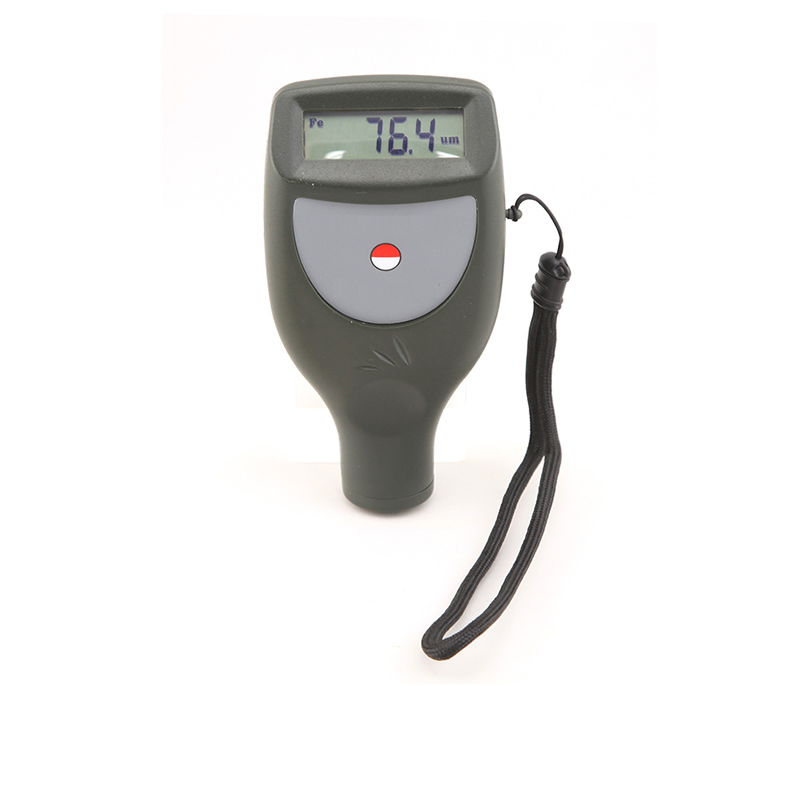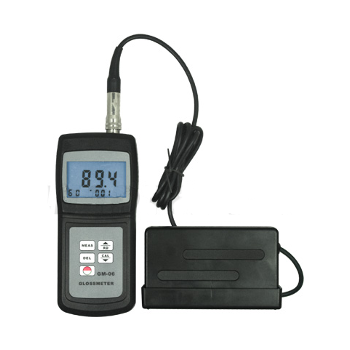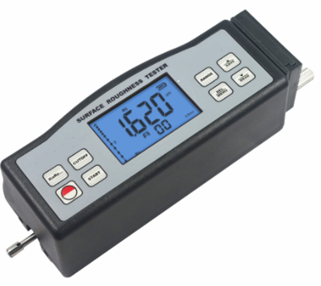Description
Overview
GAOTek Coating Thickness Gauge with 2 Modes (Buzz Reminder) is a compact easy to operate device which is used to measure the thickness of magnetic materials and non-magnetic materials. The F probe measures thickness of non-magnetic materials like paint, plastic, copper, zinc etc. on magnetic materials and N probe measures thickness of non-magnetic coatings on non-magnetic metals. It is used on anodizing, varnish, paint, non-magnetic steel etc. It is light in weight, easy to carry and convenient to operate device which has a resolution of 0.1 um to 1 um and a wide range of 0 ~ 1250 um / 0 ~ 50 mil. The device is suitable for the laboratory and for use in harsh field conditions. GAOTek Coating Thickness Gauge is used to measure the thickness and corrosion of pressure vessels, chemical equipment, boilers, and oil storage tanks etc.in industries of petroleum, shipbuilding, power station, and machine manufacturing.
Key Features
- Automatic substrate recognition.
- Manual or automatic shutdown.
- One key operation, fast and convenient
- Metric/Imperial conversion.
- Digital display gives exact reading with no guessing or errors.
- Can communicate with PC computer for statistics and printing by the optional cable and the software for RS232C interface.
- It meets the standards of ISO2178 and ISO-2360 as well as DIN, ASTM and BS.
- The N probes measure the thickness of non-magnetic coatings on non-magnetic metals.
- The F probes measure the thickness of non-magnetic materials on magnetic materials
- Suitable for the laboratory and for use in harsh field conditions.
- Two measurement mode: Single and Continuous
- Wide measuring range and high resolution.
Technical Specifications
| Display | 4 digits, 0.39 in (10 mm) LCD | |
| Operating Principle | Magnetic Induction / Eddy Current (F / NF) | |
| Range | 0 ~ 1250 µm / 0 ~ 50 mil | |
| Resolution | 0.1 µm (0 ~ 99.9 µm)
1 µm (over 100 µm) |
|
| Accuracy | ± 1 ~ 3 % n or ± 2.5 µm | |
| Minimum Radius Workpiece | F Type | Convex 0.59 in (1.5 mm) / Concave 0.98 in (25 mm) |
| NF Type | Convex 0.12 in (3 mm) / Concave 1.97 in (50 mm) | |
| Minimum Measuring Area | 0.236 in (6 mm) | |
| Minimum Sample Thickness | 0.012 in (0.3 mm) | |
| PC Interface | RS232C interface | |
| Power Supply | 4 x 1.5 AAA (UM – 4) battery | |
| Humidity | < 80 % | |
| Size | 5.0 in x 2.6 in x 1.1 in (126 mm x 65 mm x 27 mm) | |
| Weight | About 0.18 lbs. (81 g) (Without batteries) | |
| Operating Temperature | 32 °F ~ 122 °F (0 °C ~ 50 °C) | |
Additional Information
Accessories:
- F probe (in built) 1 pc.
- N probe (in built)-1 pc.
- Calibration foils-1set
- Substrate Iron -1 pc.
- Substrate (Aluminum)-1 pc.
- Carrying case -1 pc.
- Operation manual 1 pc.
Optional accessories:
- Cable & software for RS232C
Front Panel Descriptions

3-1 Probes inbuilt
3-2 Display
3-3 Zero/Power Key
3-4 Battery Compartment/Cover
3-5 Jack for RS232C interface
MEASURING PROCEDURE
- Press the power key (3-3) to switch on the gauge and ‘0’ displays on the Display (3-2). The gauge will restore the state of last operation itself, with a symbol ‘Fe’ or ‘NFe’ indicating on the Display.
- Place the probe (3-1) onto a coating layer to be measured.
- To take the next measurement, just lift the probe (3-1) to more than 1 centimeter and then repeat the step 2.
- If suspecting the accuracy of measurement, you should calibrate the gauge before taking the measurements.
- The gauge can be switched off by pressing the Power key (3-3). On the other side, the gauge will power itself off about 50 seconds after the last operation.
- To change the measurement unit ‘um’ or ‘mil’ by depressing Power key and not releasing it till ‘UNIT’ on the Display. And the unit changes after releasing the power key. It takes about 6 seconds from starting depressing Power key.
- To change measurement mode from the single to continuous or vice visa, just depressing the power key and not releasing it till ‘SC’ on the Display. And the measurement mode changes after releasing the power key. The symbol ‘
 ‘ represents continuous mode and ‘S’ represents single mode. It is about 8 seconds from starting depressing Power key.
‘ represents continuous mode and ‘S’ represents single mode. It is about 8 seconds from starting depressing Power key.
CALIBRATION
Zero adjustment
- Zero calibration for ‘Fe’ and ‘NFe’ should be carried out separately. Take the iron substrate if ‘Fe’ on the Display and take the aluminum substrate if ‘NFe’ on the Display.
- Place the probe (3-1) on the substrate steadily. Press the zero Key (3-3) and ‘0’ will be on the Display before lifting the probe. If pressing the ZERO key but the probe is not placed on the substrate or an uncoated standard, the zero calibration is invalid.
- Select an appropriate calibration foil according to your measurement range.
- Place the standard foil selected onto the substrate or the uncoated standard.
- Place the sensor (3-1) mildly onto the standard foil and lift. The reading on the display is the value measured. The displayed reading can be corrected by pressing the UP button A or down button B (which are located in the battery compartment) while the probe is away from the substrate or the measured body.

Repeat step 4 until the result is correct.
BATTERY REPLACEMENT
- When it is necessary to replace the battery, the battery symbol ‘
 ‘ will appear on the Display.
‘ will appear on the Display. - Slide the Battery Cover (3-4) away from the instrument and remove the batteries.
- Install the batteries (4×1.5v AAA/UM-4) correctly into the case.
- If the instrument is not to be used for any extended period, remove batteries.
CONSIDERATIONS
- In order to weaken the influence of the measured material on the accuracy of measurement, it is recommended that the calibrations should be done on the uncoated material to be measured.
- Probes will eventually wear. Probe life will depend on the number of measurements taken and how abrasive the coating is. Replacement of a probe can be fitted by qualified persons only.
RESTORE FACTORY SETTINGS
When to restore?
It is recommended to restore factory settings in the one of following cases.
- The gauge does not measure any more.
- Measurement accuracy is degraded caused by the abraded probe or by environmental conditions changed greatly.
How to restore?
Restore factory settings includes ‘Fe’ setting and ‘NFe’ setting. You can restore one of them or both of them respectively. Please follow procedures below to restore factory settings.
- Please note the symbol on the display is ‘Fe’ or ‘NFe’. If ‘Fe’ is on the display, the operation below is restoring the factory setting for ‘Fe’ type and if ‘NFe’ is on the display, the operation below is restoring the factory setting for ‘NFe’ type.
- Depress Power key and not release it till ‘CAL’ appears on the Display. It is about 6 seconds from starting depressing Power key.
- When F: H or nF: H is on Display, lift the probe to more than 5 centimeters. Then press the Zero Key again and the gauge returns to measurement state. The factory setting is restored.
How to improve the accuracy of full range by Ln
It is strongly recommended that no changes should be made to the value of Ln which will seriously affect the accuracy. Its value can be adjusted by professional persons only.To call the Ln, just depressing the power key and not release it until Ln shows on the display. It takes about 13 seconds from starting depressing Power key. After releasing the power key, the Ln value shows on the display.The Ln value can be changed by Up/Down key generally, larger the value of Ln, smaller will be the reading on a same thickness. A little variation of value of Ln will cause a great change in reading at high end (e.g. at 500 µm /20 mil). The rules to adjust the value of Ln are as follows:
- Reading at low end can be adjusted to the exact value by the Up or down key.
- To enlarge the Ln if readings at low end (e.g. at 51 µm) is ok but reading at high end (e.g. at 432 µm) is too large. On the contrary, to decrease the Ln if reading at low end (e.g. at 51 µm is ok but reading at high end (e.g. at 432 µm) is too small.
- Repeat procedures from A to B till the readings on the every standard foil are satisfying the accuracy.



